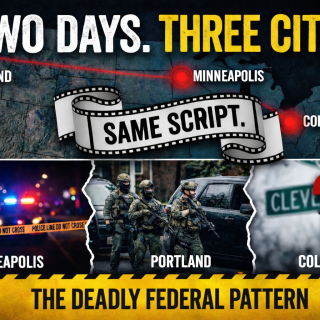Advertisement
It’s maddening that the three words “Black Lives Matter” is so hard to say for some of our public officials. Those in the majority of the Ohio Assembly, where a resolution was introduced to declare racism a public health crisis earlier this month, would do our country a great service in urging their allies to learn to say it and mean it. But considering that the US Vice President won’t say it, those of us who’ve been in the streets proclaiming it shouldn’t be surprised when so few people in power are willing to use those words, let alone show up in the streets to say it with us.
As someone who’s worked with both organized labor and justice-seeking organizations from before the first shot in this recent uprising was fired—who has participated in dozens of direct actions, petition drives, and various other campaigns that either directly or secondarily had to do with racism—I have a question. As someone who, like anyone with a shred of empathy within them, was horrified in watching any portion of the 8:46 video in which yet another police officer murdered another Black man, I have a caveat to this support.
My question is simple: “Why now?”
The obvious answer is that cities across the country—including this one—have been on fire since late May of this year in reaction to the murders of Ahmaud Arbery, Breonna Taylor, and George Floyd, and everyone needs to do something of substance to put out the fire. But when John Crawford—a 22-year-old father—was murdered by police for picking up a toy gun in a Wal-Mart, lawmakers in Ohio did nothing of substance about it. When Tamir Rice—a 12-year-old boy—was murdered by the police for playing with a toy gun in broad daylight, lawmakers in Ohio did nothing of substance. After living under a federal administration that began its campaign singling out Mexican immigrants and encouraging its supporters to “beat the hell out of” Black Lives Matter activists for the last three years, our lawmakers—from state houses to city and village councils—did nothing of substance.
When Marshawn McCarrell—who, as a co-founder of the Ohio Student Association, helped alert the world to Crawford’s murder—put a pistol on his temple and pulled the trigger at the foot of the Ohio Statehouse, no one in the chamber decided to explore the connection between racism and mental health. Amber Evans mobilized thousands to demand that the deaths of Ty’ree King—a 13-year-old Black boy shot in the back by cavalier Columbus police, Henry Green—a 23-year-old Black man shot by cavalier undercover cops who never bothered to identify themselves, Ja’ron Thomas—a 36-year-old Black man with a mental illness who was murdered by police responding to his distress call and every other Black man, boy, girl, or woman shot by an out-of-control police force. When Amber went missing 22 days after Hearcel Craig took office, found weeks later with a death ruled a suicide and several articles arose across the state about the connection between political organizing around Black issues and the state of our mental health, no one in the Statehouse—including her newly-elected State Senator, Mr. Craig—did anything of substance.
The infant mortality rate for Black babies in 43207 has been the highest in the United States for years. While the state and city have taken steps to protect the health and wellness of Black mothers in recent times, people with more in-depth knowledge than I have expressed a frustration in a lack of substantive actions taken on that front as well.
And then the coronavirus epidemic began. COVID-19 affects the immunocompromised and those over 65 most severely and has infected a disproportionate amount of Black people. At the onset of this pandemic and the subsequent isolation of the entire state and most of the country, testing was difficult to come by and the overlap of 1.7 M Black people and 2.5M people over the age of sixty were put at risk.
That I know of, my State Senator falls under two of those categories. He’s always struck me as particularly healthy. His handshake and his laugh are, anyway.
The day after Memorial Day, a video of a Black man named George Floyd being slowly murdered by a Minneapolis police department went viral. (We’d heard the names of Ahmahd Arbery and Breonna Taylor, but not seen them shot in the back by ex-police White Nationalist Terrorists or in her bed while sleeping, respectively.) By that Thursday, beyond sick of all that this racist disease had inflicted upon us, millions of people across the country took to the streets to demand justice.
On Saturday, May 30th, Council President Shannon Hardin, Congresswoman Joyce Beatty, and County Commissioner Kevin Boyce went to the protests right outside of the walls of the Statehouse. The Council President and Congresswoman were pepper-sprayed by an over-zealous, over-militarized, under-trained and possibly over-tired policeman that day. A photo of a masked commissioner Boyce helping clear said pepper spray from the Council President’s eyes was on the front page of the Columbus Dispatch the next day.
My State Senator is a former member of Columbus City Council, an institution that our City Council President was raised in as the son of the executive assistant to the city’s longest-serving mayor.
I first entered City Hall in 2014 as part of a group running a city-wide campaign. Every time that I have been inside of Columbus City Hall, our Council President has occupied a seat on Council. Every time that I have been in that chamber, I have either been rank-and-file or leadership of a group that has asked, pleaded, then demanded that our city government does something of substance about the scourge of post-modern racism in this city and, by extension, this state.
A week after the photo-op-gone-wrong involving Rep. Beatty and Council President Hardin and County Commissioner Kevin Boyce, Senator Hearcel Craig spoke to a crowd of people sorely hurting from years of abuse and sickness.
Senator Craig is my state Senator, a man whose hand I’ve shaken, words exchanged and whom I find to be a dedicated (if not necessarily daring) public servant, who belongs to the fraternity whose members through brotherhood with my father and brother have gotten me through some of the most difficult times in my life. He spoke passionately and clearly about the safety of his family, about the recent set of murders by police and intimidation tactics by domestic terrorists. He mentioned this revolution, which brings me to this statement of qualified support for the resolution in discussion in the State Senate.
So, “Why now?”
People have been talking about this public health crisis for years and negotiated, begged, petitioned, and pleaded for help.
Maybe it’s because the community has hurt for years.
Maybe it’s because three colleagues from the Democratic Party power center were pepper-sprayed and it made national news.
Maybe it’s because members of every legislative body in the country have been piecemealing for too long. The two state senators who co-authored the CR being debated in the Ohio Senate and every Black Democrat in the state of Ohio knows that The Ohio House of Representatives is over-run by people riddled with the virus known as individual racism and who perpetuate systemic racism with every refusal to wear a mask in public or to include Black people in the process of empowering and uplifting the Black people police have been denying housing to, starving, choking, hosing, tear-gassing, hanging, shooting, pepper spraying and a whole slew of other atrocities since the inception of the country.
And this leads me to the caveat.
I’ve been at the statehouse for an hour or two five days per week since the day before Council President Hardin was pepper-sprayed. In what will probably be considered his greatest lecture if not his funniest routine, “8:46,” Dave Chapelle says two primary things of the current uprising: first, that any one who saw any portion of the murder of George Floyd would take the wrath of God with them into the streets, and second that those streets would speak for themselves.
And they are.
Tomorrow, July 1st, 2020, will mark the beginning of the fifth week of this round of protests for Black Lives. I’ve watched as some of the most extraordinary young people I’ve ever seen take to the streets every day. Is it an “orderly” protest? Some times. Is it nonviolent from our end? Always.
But the young people in the lead of this movement have been mobilized since many of them can remember. Since Sandy Hook in 2012, increasingly younger and younger activists, organizers, and leaders are developed. They’ll be out in those streets holding protests, block parties, art fairs, and everything else they can to raise awareness to the evils this disease of racism—of which police brutality and, yes, The President of the United States and all of his enablers—have inflicted on them and all of us.
The caveat is that they know all these things, because they can find objective information and discern it for what it is rather than what we tell them it is. After you get to a certain age, you can tell when other people are lying to you even if you’ve lied to yourself your whole life. The people leading this movement aren’t old enough to have built up too many of those habits and will know immediately whether you’ve lied to them, they’re registering to vote every day and taught its value at every turn.
This resolution is a good thing, but it’s long overdue and I pray that it leads toward an end to these diseases we’ve fought for months and years on end.
Black Lives Matter.




